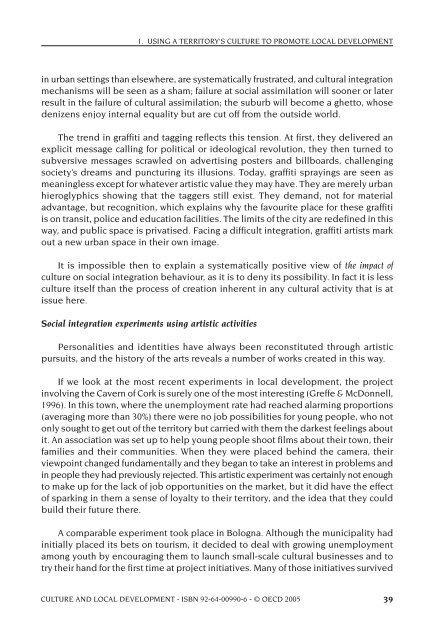OECD Culture and Local Development.pdf - PACA
OECD Culture and Local Development.pdf - PACA
OECD Culture and Local Development.pdf - PACA
You also want an ePaper? Increase the reach of your titles
YUMPU automatically turns print PDFs into web optimized ePapers that Google loves.
1. USING A TERRITORY’S CULTURE TO PROMOTE LOCAL DEVELOPMENT<br />
in urban settings than elsewhere, are systematically frustrated, <strong>and</strong> cultural integration<br />
mechanisms will be seen as a sham; failure at social assimilation will sooner or later<br />
result in the failure of cultural assimilation; the suburb will become a ghetto, whose<br />
denizens enjoy internal equality but are cut off from the outside world.<br />
The trend in graffiti <strong>and</strong> tagging reflects this tension. At first, they delivered an<br />
explicit message calling for political or ideological revolution, they then turned to<br />
subversive messages scrawled on advertising posters <strong>and</strong> billboards, challenging<br />
society’s dreams <strong>and</strong> puncturing its illusions. Today, graffiti sprayings are seen as<br />
meaningless except for whatever artistic value they may have. They are merely urban<br />
hieroglyphics showing that the taggers still exist. They dem<strong>and</strong>, not for material<br />
advantage, but recognition, which explains why the favourite place for these graffiti<br />
is on transit, police <strong>and</strong> education facilities. The limits of the city are redefined in this<br />
way, <strong>and</strong> public space is privatised. Facing a difficult integration, graffiti artists mark<br />
out a new urban space in their own image.<br />
It is impossible then to explain a systematically positive view of the impact of<br />
culture on social integration behaviour, as it is to deny its possibility. In fact it is less<br />
culture itself than the process of creation inherent in any cultural activity that is at<br />
issue here.<br />
Social integration experiments using artistic activities<br />
Personalities <strong>and</strong> identities have always been reconstituted through artistic<br />
pursuits, <strong>and</strong> the history of the arts reveals a number of works created in this way.<br />
If we look at the most recent experiments in local development, the project<br />
involving the Cavern of Cork is surely one of the most interesting (Greffe & McDonnell,<br />
1996). In this town, where the unemployment rate had reached alarming proportions<br />
(averaging more than 30%) there were no job possibilities for young people, who not<br />
only sought to get out of the territory but carried with them the darkest feelings about<br />
it. An association was set up to help young people shoot films about their town, their<br />
families <strong>and</strong> their communities. When they were placed behind the camera, their<br />
viewpoint changed fundamentally <strong>and</strong> they began to take an interest in problems <strong>and</strong><br />
in people they had previously rejected. This artistic experiment was certainly not enough<br />
to make up for the lack of job opportunities on the market, but it did have the effect<br />
of sparking in them a sense of loyalty to their territory, <strong>and</strong> the idea that they could<br />
build their future there.<br />
A comparable experiment took place in Bologna. Although the municipality had<br />
initially placed its bets on tourism, it decided to deal with growing unemployment<br />
among youth by encouraging them to launch small-scale cultural businesses <strong>and</strong> to<br />
try their h<strong>and</strong> for the first time at project initiatives. Many of those initiatives survived<br />
CULTURE AND LOCAL DEVELOPMENT - ISBN 92-64-00990-6 - © <strong>OECD</strong> 2005 39














